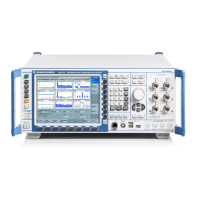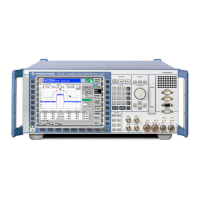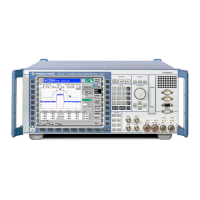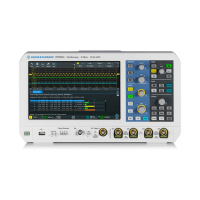Command Reference - Base Software
R&S
®
CMW500
196User Manual 1173.9463.02 ─ 06
Command Parameters/
Remarks
Short Description
*SAV – SAVe 0...99
no query, not IEEE
488.2-confirmed
Stores the current instrument settings under the specified num-
ber in an intermediate memory. The settings can be recalled
using the command *RCL with the associated number. To trans-
fer the stored instrument settings to a file see MMEMory:
STORe:STATe on page 223.
See also MMEMory:SAV on page 222 and chapter 4.3, "Save/
Recall Dialog", on page 82.
*SRE – Service
Request Enable
0...255 Sets the service request enable register to the value indicated.
Bit 6 (MSS mask bit) remains 0. This command determines under
which conditions a service request is triggered. The query *SRE?
returns the contents of the service request enable register in dec-
imal form. Bit 6 is always 0.
Alternatively *XSRE can be used with a comma separated list of
mnemonics enclosed in brackets. Mapping for bit 7, 5, 4, 3, 2:
OPER,ESBit,MAV,QUES,ERR. Example: *XSRE (ESBit,MAV)
sets bit 5 and 4 (ESB bit and MAV bit).
*SRQ? – Service
ReQuest
[timeout in ms]
query only, not IEEE
488.2-confirmed
Waits until a service request is generated (or the timeout expires)
and returns a status information:
●
1 indicates that a service request has been generated
●
0 indicates that the timer has expired (no service request)
If no timeout is specified and no service request is generated, the
command waits inifinitely. Other timers e.g. of the remote control
interface may expire in that case.
*STB? – STatus
Byte query
–
query only
Reads the contents of the status byte in decimal form.
Alternatively *XSTB? can be used to return the result as comma
separated list of mnemonics enclosed in brackets. For values see
*XPRE.
*WAI – WAIt to con-
tinue
–
no query
Prevents servicing of the subsequent commands until all preced-
ing commands have been executed and all signals have settled
(see also *OPC).
To perform this command for all sub-instruments use *GWAI
instead.
6.2 Emulation Codes
Remote control connections via USB, HiSLIP, VXI-11 or GPIB support low-level control
messages (e.g. for polling) via interface functions. In contrast, a VISA socket resource
provides no protocol functions for this purpose. Instead emulation codes can be trans-
ferred to emulate interface messages.
Most emulation codes are described in the IEEE 1174 standard. The following table pro-
vides an overview. Some messages depend on the protocol mode, see also Direct Socket
Communication.
Emulation Codes
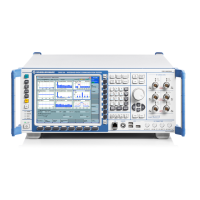
